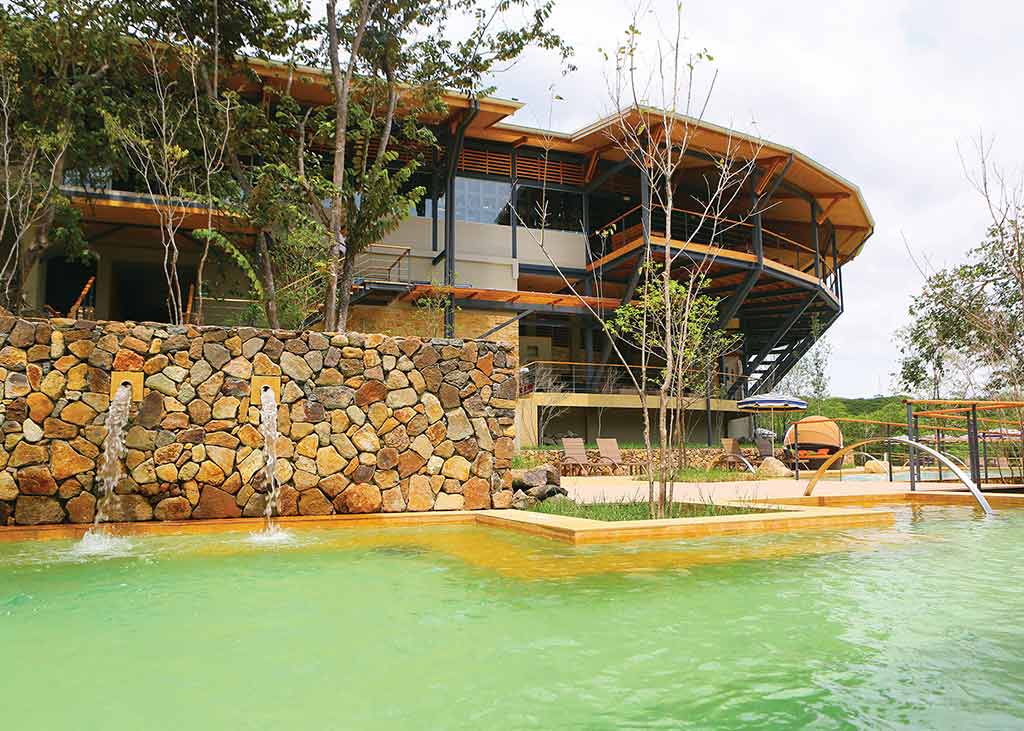The small, nondescript town of Bagaces is on Highway 1, about 22 kilometers (14 miles) north of Cañas. Bagaces is the gateway to Parque Nacional Palo Verde (west) and Volcán Miravalles (east).
Boardwalks lead through the crater itself, with mud pools and fumaroles hissing and bubbling all around.Highway 164 leads northeast from Bagaces and climbs steadily up the western shoulder of Volcán Miravalles (2,028 meters/6,654 feet), enshrined within the Zona Protectora Miravalles (Miravalles Protected Zone). The almost perfectly conical volcano is the highest in the Cordillera de Guanacaste. The western slopes are covered with savanna scrub; the northern and eastern slopes are lush, fed by moist clouds that sweep in from the Caribbean. The southern slopes are cut with deep canyons and licked by ancient lava tongues, with fumaroles spouting and hissing like mini Old Faithfuls. The forests, replete with wildlife, are easily accessed from the road. There are no developed trails or facilities for visitors, however, and no ranger station.![Miravalles volcano rises above a thermal area on its SW flank. Photo © William Melson (Smithsonian Institution) [Public domain], <a href="https://commons.wikimedia.org/wiki/File%3AMiravalles_volcano.jpg">via Wikimedia Commons</a>.](https://www.holidaytravel.cc/Article/UploadFiles/201602/2016021614530751.jpg)
Miravalles volcano rises above a thermal area on its SW flank. Photo © William Melson (Smithsonian Institution) [Public domain], via Wikimedia Commons.
Highway 164 runs via the village of Guayabo, 21 kilometers (13 miles) north of Bagaces (it has a bank, an Internet café, and several cabinas). It is paved as far as Aguas Claras and extends beyond to the hamlet of San José in the northern lowlands. If you’re souvenir shopping, call in at Galería Tony Jiménez (tel. 506/8821-8358), midway between Guayabo and Aguas Claras.A loop road from Highway 164 leads east via the community of La Fortuna de Bagaces to Las Hornillas (Little Ovens), an area of intensely bubbling mud pots and fumaroles expelling foul gases and steam. Here the Costa Rican Institute of Electricity (ICE) harnesses geothermal energy for electric power, with two plants that tap the superheated vapor deep within the volcano’s bowels. You can visit the main geothermal plant, Planta Miravalles (tel. 506/2673-1111, ext. 232), about two kilometers (1.2 miles) north of Fortuna, by appointment.
The prime spot to enjoy the volcanic activity is the mesmerizing Las Hornillas Volcanic Activity Center (tel. 506/8839-9769, 8am-5pm daily, $35), a “walkable live crater” two kilometers (1.2 miles) southeast of the ICE geothermal plant. Boardwalks lead through the crater itself, with mud pools and fumaroles hissing and bubbling all around. You can walk around at will and even take a therapeutic bath in warm mud, while a two-hour guided tour ($45) includes a tractor tour to waterfalls. A highlight is the 100-meter-long (330-foot-long) waterslide. It recently added three pedestrian swing bridges. It has showers and toilets, plus four cabins ($50 s, $100 d, including unlimited use of the facility).
“Wow” was my first reaction on seeing the deluxe Río Perdido Activity Center (tel. 506/2673-3600, 9am-5pm daily), which opened in 2013 in a previously unexplored river valley on the southern slopes of Volcán Miravalles. In fact, the name Río Perdido (Lost River) refers to its remote location near the hamlet of San Bernardo de Bagaces, northeast of Bagaces. It encompasses a 200-hectare (500-acre) semideciduous forest reserve atop the Río Blanco canyon, framed by 46-meter (150-foot) soaring rock walls.

Thermal swimming pool at Río Perdido Activity Center. Photo © Christopher P. Baker.
At its core is a very sophisticated restaurant and spa, with stunning contemporary architecture and panoramic views through a curvilinear floor-to-ceiling wall of glass overlooking a swimming pool—one of three that grace the property. Gourmet nouvelle dining is strongly influenced by traditional Guanacastecan cuisine, courtesy of chef Andrés Flores, who is also a champion downhill biker. In fact, the center is billed not least as a bike park. Flores helped design the 19-kilometer (12-mile) network of dedicated bike trails ($12) that is a highlight of Río Perdido.
You can also rent bicycles ($30-40) with advance notice, or sign up for a guided tour. Visitors also get to thrill to white-water rafting on the Río Blanco, or tubing on the Río Cuipilapa. The canyon is a setting for adrenaline-inducing aerial zip lines and Tarzan swing (“Canyon Adventure,” $48). Plus you can go tubing ($40). The center’s coup de grâce is probably its chic full-service spa for soothing away any aches after all the activity.
The no-frills Centro Turístico Yökö (tel. 506/2673-0410, $40 s, $60 d) has 12 spacious, simply furnished, and perfectly comfortable cabins with verandas with volcano views, plus ceiling fans and large walk-in showers with hot spring water. It has a restaurant with a TV. Rates include breakfast and use of the facilities.
Río Perdido Activity Center (tel. 506/2673-3600, low season $200 s/d, high season $220 s/d) will delight sophisticates who appreciate fine contemporary taste. Its 20 stupendously stylish, postmodernist, modular, steel-shell bungalows are a city-slickers delight with glazed concrete floors, stainless steel highlights, glass walls, and lively yet calming Ikea-style furnishings, plus decks with hammocks. They’re set well apart amid the dry forest, plus you get the superb restaurant, spa, and other facilities at hand.
A good resource is the Cámara de Turismo Tenorio-Miravalles (tel. 506/2466-8221, 9am-3pm daily), the local Chamber of Tourism, on the south side of Bijagua.
Buses (tel. 506/2221-3318) for Guayabo depart San José from Calle 12, Avenidas 3/5, at 5:30am and 2pm daily and travel via Bagaces.
Excerpted from the Tenth Edition of Moon Costa Rica.